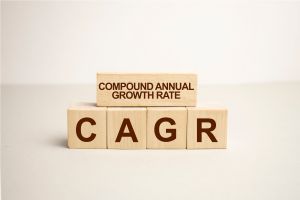
While deciding to invest in a mutual fund scheme or any other investment option, one thing that constantly plays on your mind is how much you are going to earn from it. While you can know the exact rate of return from a fixed-income instrument such as a fixed deposit, it isn’t the case with mutual funds.
Since mutual funds are market-linked instruments, the returns generated by them can vary as per market performance. But it is possible to estimate your returns using different methods, one of them being the Compound Annual Growth Rate or CAGR.
Continue reading to know what CAGR is, how to calculate CAGR for mutual fund investments, and why it is important.
CAGR – What is it?
This four-letter abbreviation is the measure of how your investments have grown annually over time after taking the power of compounding into consideration. In the case of mutual funds, CAGR reflects the average returns generated in a year.
Importance of CAGR – Why it matters
If someone asks you how much your investment has earned, you will inadvertently tell them your absolute returns, which is the growth of your investment irrespective of the tenure. For example, suppose you have invested Rs. 50,000 in a mutual fund scheme and after three years, your investment grows to Rs. 85,000. In this case, the absolute return generated by your fund is 70%.
This may seem a lot. However, when you look at the CAGR of your investment, your perspective will change. This is because you will know how much your investment has actually grown over each year.
In the example above, your CAGR would be 19.35%, which means your investment has given you an average return of 19.35% annually over the past three years.
Calculation of CAGR – The number game
You can calculate the CAGR of your mutual fund investments anytime using a mathematical formula. You will need the beginning value of your investment, the ending value, and the number of years for which it was invested. Then, you can divide the ending value of your investment with the beginning value and raise that figure to the inverse number of years before subtracting 1 from the total figure.
Here’s the formula:
CAGR = [(Ending value of your investment / Beginning value) ^ (1/Number of years)] – 1
Does that seem a lot? Don’t worry! You can simply use an online CAGR calculator to estimate your returns in no time.
Limitations of CAGR – The other side of the coin
While CAGR can be a very good indicator of your fund’s average annual performance over the years, it does not reflect market volatility. It assumes that the growth of your investment was constant during the entire investment horizon. Therefore, CAGR can provide misleading results in the short term.
To conclude
CAGR helps you measure the growth of your investment over time. However, the same may not be very useful in the case of a Systematic Investment Plan (SIP). SIPs involve investments at regular intervals, but CAGR is calculated only based on the initial and the final investment value. Thus, you can look at other types of mutual fund returns for better estimation.
An investor education initiative by Edelweiss Mutual Fund
All Mutual Fund Investors have to go through a onetime KYC process. Investor should deal only with Registered Mutual Fund (RMF). For more info on KYC, RMF and procedure to lodge/redress any complaints, visit - https://www.edelweissmf.com/kyc-norms
MUTUAL FUND INVESTMENTS ARE SUBJECT TO MARKET RISKS, READ ALL SCHEME RELATED DOCUMENTS CAREFULLY
Trending Articles
MUTUAL FUND INVESTMENTS ARE SUBJECT TO MARKET RISKS, READ ALL SCHEME RELATED DOCUMENTS CAREFULLY.





















